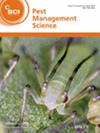求助PDF
{"title":"两种谷胱甘肽 S 转移酶基因的特征与 Bradysia odoriphaga 的噻虫嗪抗性有关","authors":"Xingyu Ma, Junjie Zeng, Chunni Zhang, Wu Dai","doi":"10.1002/ps.8535","DOIUrl":null,"url":null,"abstract":"BACKGROUNDGlutathione <jats:italic>S</jats:italic>‐transferase (GST) is a key phase II detoxification enzyme involved in xenobiotics metabolism, and plays a pivotal role in the evolution of resistance to various types of insecticides. However, the specific functions of GST genes in clothianidin resistance remain obscure in <jats:italic>Bradysia odoriphaga</jats:italic>.RESULTSHere, a specific GST inhibitor, diethyl maleate (DEM), significantly increased the mortality of <jats:italic>Bradysia odoriphaga</jats:italic> larvae following exposure to clothianidin, and the activity of GST enzyme in clothianidin‐resistant (CL‐R) strain of <jats:italic>Bradysia odoriphaga</jats:italic> was markedly greater than that in the SS strain. Two sigma <jats:italic>BoGSTs</jats:italic> (<jats:italic>BoGSTs1</jats:italic> and <jats:italic>BoGSTs2</jats:italic>) were markedly overexpressed in the CL‐R strain and exhibited a higher abundance in the Malpighian tubules or midgut. Exposure to clothianidin resulted in a significant increased expression of <jats:italic>BoGSTs1</jats:italic> and <jats:italic>BoGSTs2</jats:italic>. The knockdown of <jats:italic>BoGSTs1</jats:italic> and <jats:italic>BoGSTs2</jats:italic> increased sensitivity of larvae to clothianidin in the resistant strain. Furthermore, overexpression of BoGSTs1 and BoGSTs2 led to a significant increase in <jats:italic>Escherichia coli</jats:italic> cells tolerance to clothianidin. <jats:italic>In vitro</jats:italic> metabolic assays indicate that these two GSTs cannot directly metabolize clothianidin and its secondary metabolite desmethyl‐clothianidin. Disk diffusion assays and fluorescence competitive binding assays indicated that BoGSTs1 and BoGSTs2 play a critical role in clothianidin resistance by antioxidant activity and non‐catalytic binding activity. The docking results showed that BoGSTs1 and BoGSTs2 have strong binding affinity toward clothianidin.CONCLUSIONCollectively, these findings pinpoint the potential role of BoGSTs1 and BoGSTs2 in conferring insecticide resistance in <jats:italic>Bradysia odoriphaga</jats:italic> and contribute to our understanding of the underlying mechanisms of insecticide resistance. © 2024 Society of Chemical Industry.","PeriodicalId":218,"journal":{"name":"Pest Management Science","volume":"16 1","pages":""},"PeriodicalIF":3.8000,"publicationDate":"2024-11-11","publicationTypes":"Journal Article","fieldsOfStudy":null,"isOpenAccess":false,"openAccessPdf":"","citationCount":"0","resultStr":"{\"title\":\"Characterization of two glutathione S‐transferase genes involved in clothianidin resistance in Bradysia odoriphaga\",\"authors\":\"Xingyu Ma, Junjie Zeng, Chunni Zhang, Wu Dai\",\"doi\":\"10.1002/ps.8535\",\"DOIUrl\":null,\"url\":null,\"abstract\":\"BACKGROUNDGlutathione <jats:italic>S</jats:italic>‐transferase (GST) is a key phase II detoxification enzyme involved in xenobiotics metabolism, and plays a pivotal role in the evolution of resistance to various types of insecticides. However, the specific functions of GST genes in clothianidin resistance remain obscure in <jats:italic>Bradysia odoriphaga</jats:italic>.RESULTSHere, a specific GST inhibitor, diethyl maleate (DEM), significantly increased the mortality of <jats:italic>Bradysia odoriphaga</jats:italic> larvae following exposure to clothianidin, and the activity of GST enzyme in clothianidin‐resistant (CL‐R) strain of <jats:italic>Bradysia odoriphaga</jats:italic> was markedly greater than that in the SS strain. Two sigma <jats:italic>BoGSTs</jats:italic> (<jats:italic>BoGSTs1</jats:italic> and <jats:italic>BoGSTs2</jats:italic>) were markedly overexpressed in the CL‐R strain and exhibited a higher abundance in the Malpighian tubules or midgut. Exposure to clothianidin resulted in a significant increased expression of <jats:italic>BoGSTs1</jats:italic> and <jats:italic>BoGSTs2</jats:italic>. The knockdown of <jats:italic>BoGSTs1</jats:italic> and <jats:italic>BoGSTs2</jats:italic> increased sensitivity of larvae to clothianidin in the resistant strain. Furthermore, overexpression of BoGSTs1 and BoGSTs2 led to a significant increase in <jats:italic>Escherichia coli</jats:italic> cells tolerance to clothianidin. <jats:italic>In vitro</jats:italic> metabolic assays indicate that these two GSTs cannot directly metabolize clothianidin and its secondary metabolite desmethyl‐clothianidin. Disk diffusion assays and fluorescence competitive binding assays indicated that BoGSTs1 and BoGSTs2 play a critical role in clothianidin resistance by antioxidant activity and non‐catalytic binding activity. The docking results showed that BoGSTs1 and BoGSTs2 have strong binding affinity toward clothianidin.CONCLUSIONCollectively, these findings pinpoint the potential role of BoGSTs1 and BoGSTs2 in conferring insecticide resistance in <jats:italic>Bradysia odoriphaga</jats:italic> and contribute to our understanding of the underlying mechanisms of insecticide resistance. © 2024 Society of Chemical Industry.\",\"PeriodicalId\":218,\"journal\":{\"name\":\"Pest Management Science\",\"volume\":\"16 1\",\"pages\":\"\"},\"PeriodicalIF\":3.8000,\"publicationDate\":\"2024-11-11\",\"publicationTypes\":\"Journal Article\",\"fieldsOfStudy\":null,\"isOpenAccess\":false,\"openAccessPdf\":\"\",\"citationCount\":\"0\",\"resultStr\":null,\"platform\":\"Semanticscholar\",\"paperid\":null,\"PeriodicalName\":\"Pest Management Science\",\"FirstCategoryId\":\"97\",\"ListUrlMain\":\"https://doi.org/10.1002/ps.8535\",\"RegionNum\":1,\"RegionCategory\":\"农林科学\",\"ArticlePicture\":[],\"TitleCN\":null,\"AbstractTextCN\":null,\"PMCID\":null,\"EPubDate\":\"\",\"PubModel\":\"\",\"JCR\":\"Q1\",\"JCRName\":\"AGRONOMY\",\"Score\":null,\"Total\":0}","platform":"Semanticscholar","paperid":null,"PeriodicalName":"Pest Management Science","FirstCategoryId":"97","ListUrlMain":"https://doi.org/10.1002/ps.8535","RegionNum":1,"RegionCategory":"农林科学","ArticlePicture":[],"TitleCN":null,"AbstractTextCN":null,"PMCID":null,"EPubDate":"","PubModel":"","JCR":"Q1","JCRName":"AGRONOMY","Score":null,"Total":0}
引用次数: 0
引用
批量引用
Characterization of two glutathione S‐transferase genes involved in clothianidin resistance in Bradysia odoriphaga
BACKGROUNDGlutathione S ‐transferase (GST) is a key phase II detoxification enzyme involved in xenobiotics metabolism, and plays a pivotal role in the evolution of resistance to various types of insecticides. However, the specific functions of GST genes in clothianidin resistance remain obscure in Bradysia odoriphaga .RESULTSHere, a specific GST inhibitor, diethyl maleate (DEM), significantly increased the mortality of Bradysia odoriphaga larvae following exposure to clothianidin, and the activity of GST enzyme in clothianidin‐resistant (CL‐R) strain of Bradysia odoriphaga was markedly greater than that in the SS strain. Two sigma BoGSTs (BoGSTs1 and BoGSTs2 ) were markedly overexpressed in the CL‐R strain and exhibited a higher abundance in the Malpighian tubules or midgut. Exposure to clothianidin resulted in a significant increased expression of BoGSTs1 and BoGSTs2 . The knockdown of BoGSTs1 and BoGSTs2 increased sensitivity of larvae to clothianidin in the resistant strain. Furthermore, overexpression of BoGSTs1 and BoGSTs2 led to a significant increase in Escherichia coli cells tolerance to clothianidin. In vitro metabolic assays indicate that these two GSTs cannot directly metabolize clothianidin and its secondary metabolite desmethyl‐clothianidin. Disk diffusion assays and fluorescence competitive binding assays indicated that BoGSTs1 and BoGSTs2 play a critical role in clothianidin resistance by antioxidant activity and non‐catalytic binding activity. The docking results showed that BoGSTs1 and BoGSTs2 have strong binding affinity toward clothianidin.CONCLUSIONCollectively, these findings pinpoint the potential role of BoGSTs1 and BoGSTs2 in conferring insecticide resistance in Bradysia odoriphaga and contribute to our understanding of the underlying mechanisms of insecticide resistance. © 2024 Society of Chemical Industry.


